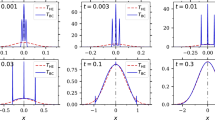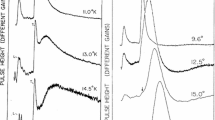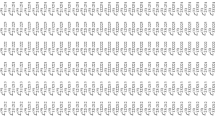Abstract
Among the three heat conduction modes (diffusive, second sound, and ballistic propagation), the ballistic one is the most difficult to model. In the present paper, we discuss its physical interpretations and show different alternatives to its modelling. We highlight two of them: a thermo-mechanical model in which the generalized heat equation—the so-called Maxwell–Cattaneo–Vernotte equation—is coupled to thermal expansion. The other one uses internal variables in the framework of non-equilibrium thermodynamics. For the first one, we developed a numerical solution and tested it on the heat pulse experiment performed by McNelly et al. on NaF samples. For the second one, we found an analytical solution that emphasizes the role of boundary conditions. This analytical method is used to validate an earlier developed numerical code.







Similar content being viewed by others
References
Tisza, L.: Transport phenomena in Helium II. Nature 141, 913 (1938)
Landau, L.: Two-fluid model of liquid Helium II. J. Phys. USSR 5, 71 (1941)
Peshkov, V.: Second sound in Helium II. J. Phys. (Moscow), 381(8) (1944)
Jackson, H.E., Walker, C.T., McNelly, T.F.: Second sound in NaF. Phys. Rev. Lett. 25(1), 26–28 (1970)
Jackson, H.E., Walker, C.T.: Thermal conductivity, second sound and phonon-phonon interactions in NaF. Phys. Rev. B 3(4), 1428–1439 (1971)
McNelly, T.F.: Second sound and anharmonic processes in isotopically pure Alkali-Halides. 1974. Ph.D. Thesis, Cornell University
Joseph, D.D., Preziosi, L.: Heat waves. Rev. Mod. Phys. 61(1), 41 (1989)
Joseph, D.D., Preziosi, L.: Addendum to the paper on heat waves. Rev. Mod. Phys. 62(2), 375–391 (1990)
Straughan, B.: Heat Waves. Springer, Berlin (2011)
Dreyer, W., Struchtrup, H.: Heat pulse experiments revisited. Continuum Mech. Thermodyn. 5, 3–50 (1993)
Ma, Y.: A transient ballistic-diffusive heat conduction model for heat pulse propagation in nonmetallic crystals. Int. J. Heat Mass Transf. 66, 592–602 (2013)
Kovács, R., Ván, P.: Generalized heat conduction in heat pulse experiments. Int. J. Heat Mass Transf. 83, 613–620 (2015)
Cimelli, V.A., Frischmuth, K.: Determination of material functions through second sound measurements in a hyperbolic heat conduction theory. Math. Comput. Modell. 24(12), 19–28 (1996)
Jou, D., Casas-Vázquez, J., Lebon, G.: Extended Irreversible Thermodynamics, 4th edn. Springer, Berlin (2010)
Alvarez, F.X., Jou, D.: Memory and nonlocal effects in heat transport: from diffusive to ballistic regimes. Appl. Phys. Lett. 90(8), 083109 (2007)
Cimmelli, V.A., Sellitto, A., Jou, D.: Nonlocal effects and second sound in a non-equilibrium steady state. Phys. Rev. B 79(1), 014303 (2009)
Cimmelli, V.A.: Different thermodynamic theories and different heat conduction laws. J. Non-Equilib. Thermodyn. 34(4), 299–333 (2009)
Rogolino, P., Cimmelli, V.A.: Differential consequences of balance laws in extended irreversible thermodynamics of rigid heat conductors. Proc. R. Soc. A 475(2221), 20180482 (2019)
Jou, D., Casas-Vázquez, J., Lebon, G.: Extended irreversible thermodynamics. Rep. Prog. Phys. 51(8), 1105 (1988)
Ván, P., Fülöp, T.: Universality in heat conduction theory—weakly nonlocal thermodynamics. Annalen der Physik (Berlin) 524(8), 470–478 (2012)
Berezovski, A., Ván, P.: Internal Variables in Thermoelasticity. Springer, Berlin (2017)
Verhás, J.: Thermodynamics and Rheology. Akadémiai Kiadó-Kluwer Academic Publisher, Amsterdam (1997)
Józsa, V., Kovács, R.: Solving Problems in Thermal Engineering: A Toolbox for Engineers. Springer, Berlin (2020)
Gyarmati, I.: Non-equilibrium Thermodynamics. Springer, Berlin (1970)
Sellitto, A., Cimmelli, V.A.: Heat-pulse propagation in thermoelastic systems: application to graphene. Acta Mech. 230(1), 121–136 (2019)
Kovács, R., Madjarević, D., Simić, S., Ván, P.: Non-equilibrium theories of rarefied gases: internal variables and extended thermodynamics. Continuum Mechanics and Thermodynamics (2020). arXiv:1812.10355
Kovács, R.: On the rarefied gas experiments. Entropy 21(7), 718 (2019)
Ignaczak, J., Ostoja-Starzewski, M.: Thermoelasticity with Finite Wave Speeds. OUP, Oxford (2009)
Müller, I., Ruggeri, T.: Rational Extended Thermodynamics. Springer, Berlin (1998)
Ruggeri, T., Sugiyama, M.: Rational Extended Thermodynamics Beyond the Monatomic Gas. Springer, Berlin (2015)
Pavić-Čolić, M., Madjarević, D., Simić, S.: Polyatomic gases with dynamic pressure: maximum entropy principle and shock structure. arXiv:1611.04018 (2016)
Arima, T., Taniguchi, S., Ruggeri, T., Sugiyama, M.: Extended thermodynamics of real gases with dynamic pressure: an extension of Meixner’s theory. Phys. Lett. A 376(44), 2799–2803 (2012)
Kovács, R., Ván, P.: Second sound and ballistic heat conduction: NaF experiments revisited. Int. J. Heat Mass Transf. 117, 682–690 (2018)
McNelly, T.F., Rogers, S.J., Channin, D.J., Rollefson, R.J., Goubau, W.M., Schmidt, G.E., Krumhansl, J.A., Pohl, R.O.: Heat pulses in NaF: onset of second sound. Phys. Rev. Lett. 24(3), 100–102 (1970)
Kovács, R., Ván, P.: Models of ballistic propagation of heat at low temperatures. Int. J. Thermophys. 37(9), 95 (2016)
Ván, P.: Theories and heat pulse experiments of non-Fourier heat conduction. Commun. Appl. Ind. Math. 7(2), 150–166 (2016)
Fülöp, T., Asszonyi, C., Ván, P.: Distinguished rheological models in the framework of a thermodynamical internal variable theory. Continuum Mech. Thermodyn. 27(6), 971–986 (2015)
Kovács, R., Rogolino, P.: Numerical treatment of nonlinear Fourier and Maxwell–Cattaneo–Vernotte heat transport equations. Int. J. Heat Mass Transf. 150, 119281 (2020)
Lubarda, V.A.: On thermodynamic potentials in linear thermoelasticity. Int. J. Solids Struct. 41(26), 7377–7398 (2004)
Fülöp, T.: Chapters in thermodynamics (2019). ftp://ftp.energia.bme.hu/pub/Alkalmazott_termodinamika_BMEGEENBGAT/. Accessed 20 Jan 2021
Tóth, B.: Dual and mixed nonsymmetric stress-based variational formulations for coupled thermoelastodynamics with second sound effect. Continuum Mech. Thermodyn. 30(2), 319–345 (2018)
Frischmuth, K., Cimmelli, V.A.: Numerical reconstruction of heat pulse experiments. Int. J. Eng. Sci. 33(2), 209–215 (1995)
Frischmuth, K., Cimmelli, V.A.: Hyperbolic heat conduction with variable relaxation time. J. Theor. Appl. Mech. 34(1), 57–65 (1996)
Frischmuth, K., Cimmelli, V.A.: Coupling in thermo-mechanical wave propagation in NaF at low temperature. Arch. Mech. 50(4), 703–713 (1998)
Bargmann, S., Steinmann, P.: Finite element approaches to non-classical heat conduction in solids. Comput. Model. Eng. Sci. 9(2), 133–150 (2005)
Bargmann, S., Steinmann, P.: Modeling and simulation of first and second sound in solids. Int. J. Solids Struct. 45(24), 6067–6073 (2008)
Green, A.E., Naghdi, P.M.: A re-examination of the basic postulates of thermomechanics. Proc. R. Soc. Lond. A 432(1885), 171–194 (1991)
Green, A.E., Naghdi, P.M.: On undamped heat waves in an elastic solid. J. Therm. Stresses 15(2), 253–264 (1992)
Jou, D., Restuccia, L.: Caloric and entropic temperatures in non-equilibrium steady states. Physica A 460, 246–253 (2016)
Casas-Vázquez, J., Jou, D.: Temperature in non-equilibrium states: a review of open problems and current proposals. Rep. Prog. Phys. 66, 1937–2023 (2003)
Sellitto, A., Cimmelli, V.A.: A continuum approach to thermomass theory. J. Heat Transf. 134(11), 112402 (2012)
Guo, Y., Jou, D., Wang, M.: Macroscopic heat transport equations and heat waves in nonequilibrium states. Physica D 342, 24–31 (2017)
Saluto, D., Jou, L.: Entrance, slip, and turbulent effects in heat transport in superfluid helium across a thin layer. Zeitschrift für angewandte Mathematik und Physik 71(2), 1–15 (2020)
Walker, C.T.: Thermal conductivity of some alkali halides containing F centers. Phys. Rev. 132(5), 1963–1975 (1963)
Rieth, Á., Kovács, R., Fülöp, T.: Implicit numerical schemes for generalized heat conduction equations. Int. J. Heat Mass Transf. 126, 1177–1182 (2018)
Fülöp, T., Kovács, R., Szücs, M., Fawaier, M.: Thermodynamical extension of a symplectic numerical scheme with half space and time shifts demonstrated on rheological waves in solids. Entropy 22, 155 (2020)
Press, W.H.: Numerical Recipes 3rd Edition: The Art of Scientific Computing. Cambridge University Press, Cambridge (2007)
Jury, E.I.: Inners and Stability of Dynamic Systems. Wiley, Hoboken (1974)
Hu, R., Cao, B.Y.: Study on thermal wave based on the thermal mass theory. Sci. China Ser. E Technol. Sci. 52(6), 1786–1792 (2009)
Zhukovsky, K.: Violation of the maximum principle and negative solutions for pulse propagation in Guyer–Krumhansl model. Int. J. Heat Mass Transf. 98, 523–529 (2016)
Zhukovsky, K.V.: Exact solution of Guyer–Krumhansl type heat equation by operational method. Int. J. Heat Mass Transf. 96, 132–144 (2016)
Zhukovsky, K.V.: Operational approach and solutions of hyperbolic heat conduction equations. Axioms 5(4), 28 (2016)
Zhukovsky, K.V., Srivastava, H.M.: Analytical solutions for heat diffusion beyond Fourier law. Appl. Math. Comput. 293, 423–437 (2017)
Kovács, R.: Analytic solution of Guyer–Krumhansl equation for laser flash experiments. Int. J. Heat Mass Transf. 127, 631–636 (2018)
Mezahov-Deglin, L.P.: Thermal conductivity of pure lead crystals at low temperatures. Soviet J. Exp. Theor. Phys. 50, 369 (1979)
Mezhov-Deglin, L.P.: Possibility of observing a knudsen minimum in the thermal conductivity of insulator crystals. Sov. Phys. Sol. St. 22(6), 1018–1021 (1980)
Mezhov-Deglin, L.P., Mukhin, S.I.: Oscillations of kinks on dislocation lines in crystals and low-temperature transport anomalies as a passport of newly induced defects. Low Temp. Phys. 37(10), 806–811 (2011)
Sciacca, M., Sellitto, A., Jou, D.: Transition to ballistic regime for heat transport in helium II. Phys. Lett. A 378(34), 2471–2477 (2014)
Alvarez, F.X., Jou, D.: Boundary conditions and evolution of ballistic heat transport. J. Heat Transf. 132, 012404 (2010)
Alvarez, F.X., Cimmelli, V.A., Jou, D., Sellitto, A.: Mesoscopic description of boundary effects in nanoscale heat transport. Nanoscale Syst. Math. Model. Theory Appl. 1, 112–142 (2012)
Arima, T., Ruggeri, T., Sugiyama, M., Taniguchi, S.: Non-linear extended thermodynamics of real gases with 6 fields. Int. J. Non-Linear Mech. 72, 6–15 (2015)
Lebon, G., Cloot, A.: Propagation of ultrasonic sound waves in dissipative dilute gases and extended irreversible thermodynamics. Wave Motion 11, 23–32 (1989)
Carrasi, M., Morro, A.: A modified Navier-Stokes equation, and its consequences on sound dispersion. Il Nuovo Cimento B 9, 321–343 (1972)
Carrasi, M., Morro, A.: Some remarks about dispersion and absorption of sound in monatomic rarefied gases. Il Nuovo Cimento B 13, 281–289 (1973)
Kovács, R., Rogolino, P., Jou, D.: When theories and experiments meet: rarefied gases as a benchmark of non-equilibrium thermodynamic models (2019) arXiv: 1912.02158
Madjarević, D., Simić, S.: Entropy growth and entropy production rate in binary mixture shock waves. Phys. Rev. E 100(2), 023119 (2019)
Madjarević, D.: Shock structure and temperature overshoot in macroscopic multi-temperature model of binary mixtures. In: From Particle Systems to Partial Differential Equations II, pp. 253–272. Springer (2015)
Simić, S., Pavić-Čolić, M., Madjarević, D.: Non-equilibrium mixtures of gases: modelling and computation. Rivista di Matematica della Universita di Parma (2015)
Szücs, M., Fülöp, T.: Analytical solution method for rheological problems of solids (2018). arXiv:1810.06350
Szücs, M., Fülöp, T.: Kluitenberg–Verhás rheology of solids in the GENERIC framework. J. Non-Equilibrium Thermodyn. 44(3), 247–259 (2019)
Öttinger, H.C.: Beyond Equilibrium Thermodynamics. Wiley, Hoboken (2005)
Pavelka, M., Klika, V., Grmela, M.: Multiscale Thermo-dynamics: Introduction to GENERIC. Walter de Gruyter GmbH & Co KG, Berlin (2018)
Grmela, M.: Generic guide to the multiscale dynamics and thermodynamics. J. Phys. Commun. 2(3), 032001 (2018)
Romero, I.: Algorithms for coupled problems that preserve symmetries and the laws of thermodynamics: Part I: Monolithic integrators and their application to finite strain thermoelasticity. Comput. Methods Appl. Mech. Eng. 199(25–28), 1841–1858 (2010)
Romero, Ignacio: Algorithms for coupled problems that preserve symmetries and the laws of thermodynamics: Part II: Fractional step methods. Comput. Methods Appl. Mech. Eng. 199(33–36), 2235–2248 (2010)
Shang, X., Öttinger, H.C.: Structure-preserving integrators for dissipative systems based on reversible-irreversible splitting. Proc. R. Soc. A 476(2234), 20190446 (2020)
Acknowledgements
The authors thank Mátyás Szücs for valuable discussions. The research reported in this paper was supported by the grants of National Research, Development and Innovation Office—NKFIH 130378.
The research reported in this paper and carried out at BME has been supported by the NRDI Fund (TKP2020 NC, Grant No. BME-NC) based on the charter of bolster issued by the NRDI Office under the auspices of the Ministry for Innovation and Technology. This paper was supported by the János Bolyai Research Scholarship of the Hungarian Academy of Sciences. The authors acknowledge the financial support of the Italian Gruppo Nazionale per la Fisica Matematica (GNFM-INdAM).
Author information
Authors and Affiliations
Corresponding author
Additional information
Communicated by Andreas Öchsner.
Publisher's Note
Springer Nature remains neutral with regard to jurisdictional claims in published maps and institutional affiliations.
Appendices
Appendix A. Stability of the numerical scheme
Since the scheme that we utilize here for demonstration is at least partially explicit, we must investigate the corresponding stability properties. Following [12, 56,57,58], we use the von Neumann method and the Jury conditions, which is suitable for linear equations. However, due to the appearance of the nonlinear term \((T-T_0)\partial _xv\), we have to do first the following. Estimating the maximum of the temperature field T is making the nonlinear term to be linear with substituting a constant for T [38]. Unfortunately, it is an open mathematical question of how to make the proper estimation for T. Here, we assume that \(C=\max _{(j,n)} (T^n_j-1)\), for all x and t is 1. Next, what serves for the starting point is the discrete version of the dispersion relation, i.e. assuming the solution for the difference equations in the form of a plane wave:
in which \(\xi \) is called growth factor; this is the amplitude of the wave and must be bounded from above for stability: \(|\xi |\le 1\). Furthermore, i is the imaginary unit, and k is the wavenumber. After substituting Eq. (25) into (15), we obtain the system of linear algebraic equations:
where the coefficient matrix is
Then the characteristic polynomial for \(\xi \) can be formally expressed as
where the coefficients are found to be
The roots of that characteristic polynomial can be restricted into the unit circle on a complex plane, using Jury conditions [58], i.e.
-
\(p(\xi =1) \ge 0\);
-
\(p(\xi =-1) \ge 0\);
-
\(|a_0|\le |a_4|\);
-
\(|b_0 |>|b_3|\), where \(b_k= \left| \begin{array}{cc} a_0 &{} a_{n-k} \\ a_n &{} a_k \end{array} \right| \), with \(n =4 \) and \(k=3\);
-
\(|c_0 |>|c_2|\), where \(c_k= \left| \begin{array}{cc} b_0 &{} b_{n-1-k} \\ b_{n-1} &{} b_k \end{array} \right| \), with \(n =4 \) and \(k= 2\).
Unfortunately, the analytical form of these inequalities does not allow to simplify the expressions reasonably; therefore, we decided to check them numerically. However, let us remark that the stability conditions are in agreement with the thermodynamic restrictions, including the relations between the material parameters.
Appendix B. Analytical solutions
The complete solution of Eq. (23) is split into two parts. The first one lasts until the end of the heat pulse \(\tau _\Delta \), while the next one is having a constant boundary, independently of the time.
1.1 Section I (\(0<t\le t_\Delta \))
Starting with the first section, let us assume that we can write the heat flux in the form \(q=v+w\), in which w serves to separate the time-dependent inhomogeneous boundary from v which becomes the homogeneous solution of Eq. (23), and
Substituting Eq. (29) into (23), and executing the derivatives, we obtain the following inhomogeneous partial differential equation:
where \(f(x,t)=a\dddot{w}+b\ddot{w}+{\dot{w}}\). Using the splitting \(v=q-w\), the initial conditions for v are not completely equal to zero, that is,
Applying the classical procedure of separation of variables, we seek the solution in the form \(v(x,t)=\phi (t)X(x)\), in which \(\phi (t)\) describes the time evolution, and X(x) stands for the spatial behaviour. Furthermore, following [64], we assume that the inhomogeneity f(x, t) can be represented in the space spanned by the eigenfunctions of Laplacian operator. Thus, we determine the eigenspace for the homogeneous part (\(f(x,t)=0\)),
where \(X''/X = \beta \) yields the eigenvalues and the eigenfunctions, with the homogeneous boundaries \(X(0)=X(L)=0\):
with \(\beta _n = \Big ( \frac{n\pi }{L}\Big )^2\) being the eigenvalues. Then, exploiting the linearity of Eq. (23), v(x, t) reads
Now, we can substitute Eq. (34) into (30):
which equation requires the Fourier sin series expansion of f(x, t), i.e. \(f(x,t)=\sum _{n=1}^{\infty }f_n(t)\sin \Big ( n\pi \frac{x}{L}\Big )\), and \(f_n(t)\) is expressed using Eqs. (24) and (29):
After integration and simplification, we obtain the nth term as follows:
Now, using Eq. (37), Eq. (35) shall lead to the solution of the time evolution for v, i.e. \(\phi _n(t)\) is prescribed as
and its general solution is
where \(x_{1,2,3}\) are the roots of the characteristic polynomial \(ax^3+bx^2+(1+c\beta )x+\beta =0\), \(g=2\pi / \tau _{\Delta }\), and \(A, \ B\) are the parameters of the particular solution \(\phi _p\). Now substituting \(\phi _p=A\sin (gt)+B\cos (gt)\) into Eq. (38),
with
as well as
which system gives the expressions for A and B. In order to determine the coefficients \(Y_{1_n,2_n,3_n}\), we must take the initial conditions into account:
Formally, we obtained the solution of the heat flux q for the first session that lasts until \(\tau _\Delta \),
We can use this expression to reconstruct the temperature field, utilizing the balance of internal energy:
1.2 Section II (\(t \ge \tau _\Delta \))
Now turning our attention to the second session of the solution (in which \(t\ge \tau _\Delta \)), we introduce a new variable for time such as \({\tilde{t}}=t-\tau _{\Delta }\) for convenience. Thus, the initial conditions become
Since the inhomogeneity of f(x, t) disappears as \(w\equiv 0\), we can immediately begin with
The roots of the characteristic polynomial \(x_{1,2,3}\) remain unchanged, and the general solution reads
in which the unknown \(C_{1,2,3}\) coefficients are determined using the initial conditions (46):
Again, the temperature distribution is recovered using the balance equation.
where \({\tilde{t}}=t-\tau _{\Delta }\), and \(T_{I}(x,t=\tau _{\Delta })\) is defined by Eq. (45).
1.3 Calculating Q(x, t)
The heat current density Q(x, t) can be calculated from Eq. (18) using the previously determined T(x, t) and q(x, t) functions. The solution again is divided into two parts, namely \(Q_{I}(x,t)\) and \(Q_{II}(x,t)\), where the \(T_{I,II}(x,t)\) and \(q_{I,II}(x,t)\) functions are used accordingly. The necessary derivatives needed for Q(x, t) are the following:
Putting everything together the heat flux density for the first time interval is:
where
Similarly, the heat flux density for the second interval will be:
in which
Rights and permissions
About this article
Cite this article
Balassa, G., Rogolino, P., Rieth, Á. et al. New perspectives for modelling ballistic-diffusive heat conduction. Continuum Mech. Thermodyn. 33, 2007–2026 (2021). https://doi.org/10.1007/s00161-021-00982-9
Received:
Accepted:
Published:
Issue Date:
DOI: https://doi.org/10.1007/s00161-021-00982-9




